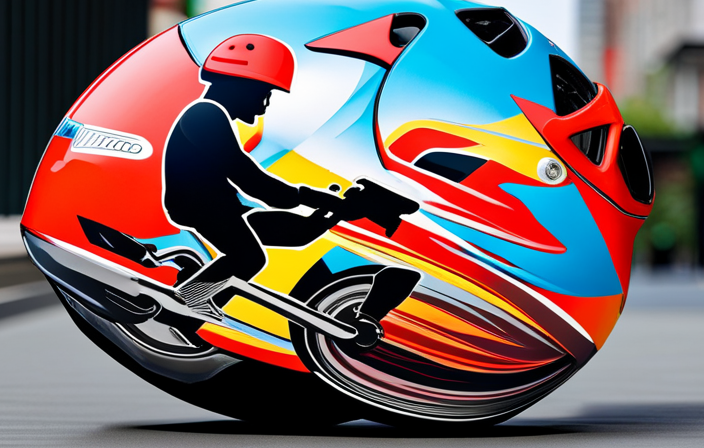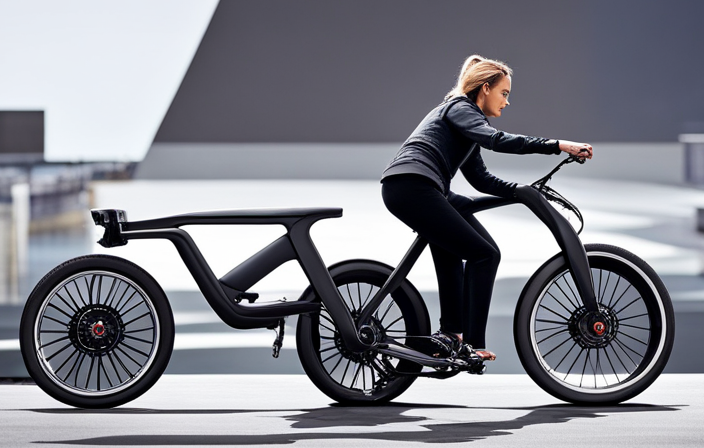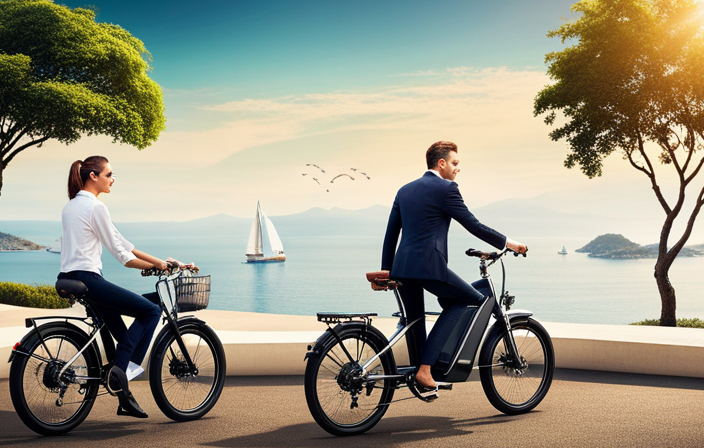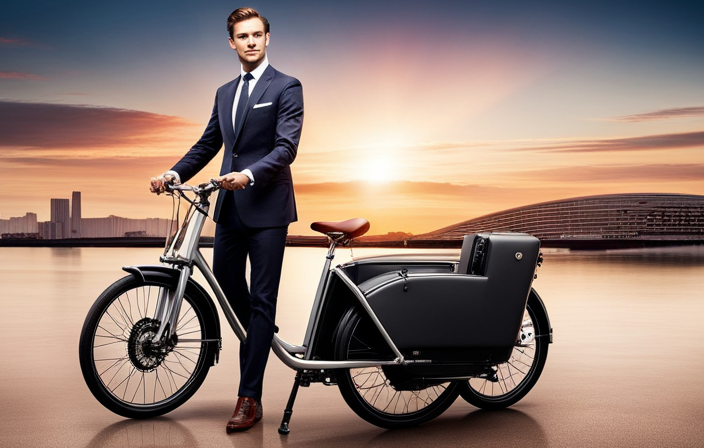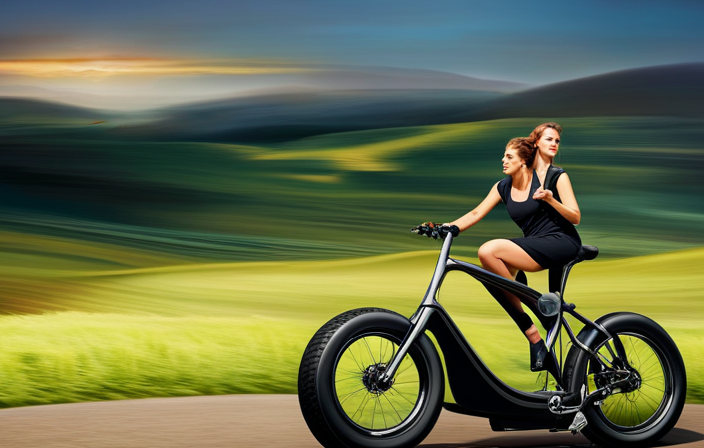Have you ever wondered how an electric bike works?
Well, let me take you on a fascinating journey into the world of e-motor electric bikes.
In this article, we will explore the basic components of an electric bike, including the electric motor, battery system, and controller.
We will also discuss the difference between pedal assist and throttle control, as well as how the motor works in conjunction with the gears.
So, buckle up and get ready to dive into the technical workings of these amazing machines.
Key Takeaways
- Generative braking enhances safety and control for e-bike riders, providing a smoother and controlled braking experience.
- Motor gearing is crucial for optimal performance, with different gear ratios maximizing efficiency and power transfer.
- Battery capacity determines the range of an e-bike, with higher capacity batteries offering longer range.
- Regular maintenance, such as cleaning, tire pressure adjustment, brake inspection, and chain lubrication, is essential for optimal e-bike function and longevity.
The Basic Components of an Electric Bike
You’ll find that the basic components of an electric bike include a motor, a battery, a controller, and a throttle.
The motor is the heart of the electric bike, responsible for converting electrical energy into mechanical power. There are various types of electric bike motors, such as hub motors and mid-drive motors, each with their own advantages and disadvantages.
The battery provides the necessary power to the motor and determines the range of the electric bike.
The controller acts as the brain of the system, regulating the flow of electricity between the battery and the motor.
Finally, the throttle allows the rider to control the speed of the electric bike.
Understanding the electric motor is crucial in comprehending how an electric bike functions as a whole, so let’s delve into this topic further.
Understanding the Electric Motor
There are several types of electric motors used in e-bikes, each with its own advantages and limitations.
The most common types include brushless DC motors, geared hub motors, and mid-drive motors.
These motors work by converting electricity into mechanical power through the use of magnets and coils, creating rotational motion that propels the bike forward.
Types of Electric Motors Used in E-Bikes
To understand the types of electric motors used in e-bikes, you’ll need to know that they come in various designs and configurations. Here are three types of electric motors commonly found in e-bikes:
-
Hub Motors: These motors are integrated into the hub of the wheel and provide direct power to it. They offer high electric motor efficiency and are known for their simplicity and reliability.
-
Mid-Drive Motors: Positioned near the bike’s bottom bracket, these motors transfer power to the bike’s drivetrain, allowing for efficient use of gears. They provide a balanced weight distribution and better handling.
-
Friction Drive Motors: These motors use a roller that contacts the bike’s tire to provide propulsion. They are lightweight and easy to install on different bike models.
Now that you’re familiar with the types of electric motors used in e-bikes, let’s explore how the motor converts electricity into mechanical power.
How the Motor Converts Electricity into Mechanical Power
The conversion of electricity into mechanical power in the motor is a fascinating process. When the electric current flows through the motor’s windings, a magnetic field is created. This magnetic field interacts with the permanent magnets inside the motor, causing them to repel or attract each other.
As a result, the rotor starts to rotate, converting electrical power into mechanical energy. This mechanical energy generation allows the e-bike to move forward. The efficiency of this conversion process is crucial for the performance and range of the electric bike.
By optimizing the design of the motor and its components, engineers strive to maximize the conversion efficiency, ensuring that a larger proportion of the electrical power is effectively converted into mechanical power. Understanding this process is essential for exploring the battery system that provides the electricity for the motor.
Exploring the Battery System
In this discussion, I will explore the battery system in e-bikes, specifically focusing on the types of batteries used and how they store and release energy.
There are several types of batteries commonly used in e-bikes, including lithium-ion, nickel-metal hydride, and lead-acid batteries. These batteries are designed to store energy from an external source, such as a charging port, and release that energy to power the electric motor when needed.
Types of Batteries Used in E-Bikes
There’s a variety of batteries used in e-bikes. The two most common types are lithium ion batteries and lead acid batteries. Lithium ion batteries are the most popular choice due to their high energy density, lightweight design, and long cycle life. They provide a higher power output, allowing for faster acceleration and better performance. On the other hand, lead acid batteries are a more affordable option with a lower energy density and weight. They have a shorter cycle life and slower charging time compared to lithium ion batteries.
Here is a comparison table of the two types of batteries:
| Lithium Ion Batteries | Lead Acid Batteries |
|---|---|
| High energy density | Lower energy density |
| Lightweight design | Heavier design |
| Long cycle life | Shorter cycle life |
| Faster charging time | Slower charging time |
Now, let’s move on to how the battery stores and releases energy.
How the Battery Stores and Releases Energy
One way batteries in e-bikes store and release energy is through a chemical reaction. When the e-bike is connected to a power source during the charging process, an electrical current flows into the battery. This current causes a chemical reaction to occur within the battery, resulting in the storage of energy.
The battery converts this electrical energy into chemical energy, which is then stored until it is needed to power the e-bike. When the rider activates the motor, the battery releases the stored energy in the form of electrical current. This current powers the motor, allowing the e-bike to move.
It is important to note that the efficiency of this energy storage and release process varies depending on the type of battery used. The role of the controller in managing this energy flow will be discussed in the subsequent section.
The Role of the Controller
You’ll need a controller to regulate the power flow in your electric bike’s motor. The controller functions as the brain of the system, responsible for managing the power supply from the battery to the motor. It controls the speed and torque of the motor by adjusting the current flowing through it.
Additionally, the controller programming determines how the motor responds to different inputs, such as throttle control or pedal assist. Through the use of sensors, the controller can monitor factors like speed, temperature, and battery voltage to ensure optimal performance and protect the motor from damage.
Now that we understand the role of the controller, let’s explore the different methods of controlling the motor: pedal assist vs. throttle control.
Pedal Assist vs. Throttle Control
The main difference between pedal assist and throttle control is the way in which the rider activates the motor.
With pedal assist, the motor is activated when the rider starts pedaling. The system measures the force applied to the pedals and provides assistance accordingly. This method is known for its efficiency, as it optimizes the use of human power while providing a boost when needed.
On the other hand, throttle control allows the rider to activate the motor by twisting a throttle grip, similar to a motorcycle. This provides instant power and responsiveness, allowing the rider to accelerate without pedaling. However, throttle control is generally less efficient than pedal assist, as it relies solely on the motor for propulsion.
Understanding the differences between these two control methods is crucial in choosing the right e-bike for your needs.
Now, let’s delve into the importance of regenerative braking.
The Importance of Regenerative Braking
After discussing the differences between pedal assist and throttle control, let’s now explore the importance of regenerative braking in e-bikes.
Regenerative braking is a feature that allows the electric motor to convert kinetic energy into electrical energy, which is then stored in the battery for later use. This not only helps to extend the overall range of the bike but also reduces the wear and tear on the brake pads, leading to cost savings on maintenance.
Additionally, regenerative braking can provide a smoother and more controlled braking experience, especially when going downhill or coming to a sudden stop. However, it’s important to note that regenerative braking has its limitations. It may not be as effective at slower speeds and on steep descents.
Nevertheless, when used in conjunction with traditional braking methods, regenerative braking can provide significant advantages to e-bike riders.
Now, let’s delve into how the motor works in conjunction with the gears.
How the Motor Works in Conjunction with the Gears
To maximize efficiency and power transfer, it’s important to understand how the motor and gears cooperate in an e-bike. The motor gearing plays a crucial role in determining the performance of the bike.
By utilizing different gear ratios, the motor can work at its optimal speed and torque. When starting from a standstill or climbing steep hills, a lower gear ratio allows the motor to exert more force, providing better acceleration and climbing ability.
On the other hand, when cruising at high speeds or riding on flat terrain, a higher gear ratio enables the motor to operate at a higher rotational speed, resulting in increased efficiency and top speed.
Understanding the relationship between the motor and gearing allows riders to optimize their e-bike’s performance and tailor it to their specific needs. This knowledge is essential in comprehending the factors that affect the bike’s range and charging time, as we will explore in the next section.
Understanding Range and Charging Time
Now that we understand how the motor works in conjunction with the gears, let’s delve into another important aspect of electric bikes: range and charging time.
The range of an e-bike refers to the distance it can travel on a single charge, which is determined by its battery capacity. A higher battery capacity means a longer range, allowing you to go on longer rides without worrying about running out of power.
Additionally, charging time is a crucial factor to consider. Thanks to fast charging technology, many e-bikes can be fully charged in just a few hours, making it convenient to top up the battery before your next adventure.
Understanding the range and charging time of your e-bike ensures that you can plan your rides accordingly and never be caught off guard with a depleted battery.
So, let’s now explore some maintenance tips to keep your e-bike running smoothly.
Maintenance Tips to Keep Your E-Bike Running Smoothly
One important aspect to consider for keeping your e-bike running smoothly is regular maintenance. By following a few simple maintenance tips, you can ensure that your e-bike performs optimally and lasts longer.
First, make sure to clean your bike regularly, removing dirt and debris that can affect its performance. Additionally, check the tire pressure and adjust it as needed to ensure a smooth and efficient ride.
Inspecting the brakes and lubricating the chain are also important maintenance tasks to keep your e-bike in top shape. In case of any issues, refer to the troubleshooting guide provided by the manufacturer.
By following these maintenance tips, you can enjoy a hassle-free ride on your e-bike.
Looking to the future, advancements in technology will continue to enhance the performance and efficiency of electric bikes.
The Future of Electric Bikes and Advancements in Technology
Advancements in technology will keep improving the performance and efficiency of e-bikes in the future. One area where we can expect significant progress is in battery technology. As batteries become more advanced, e-bikes will be able to travel longer distances and charge faster. This will greatly enhance the practicality and convenience of using electric bikes for transportation.
The impact of electric bikes on transportation cannot be understated. They provide a sustainable and eco-friendly alternative to traditional modes of transportation. With advancements in technology, e-bikes will become even more popular and widespread. Here are some key points to consider:
-
Increased Range: Advancements in battery technology will enable e-bikes to have a longer range, allowing riders to travel even greater distances without needing to recharge.
-
Faster Charging: With improved battery technology, e-bikes will be able to charge at a much faster rate, reducing downtime and increasing convenience for riders.
-
Integration with Smart Systems: Future e-bikes may be equipped with smart systems that allow for seamless integration with other modes of transportation, such as public transit or ride-sharing services.
Advancements in technology will continue to shape the future of electric bikes, making them an increasingly viable and sustainable option for transportation.
Frequently Asked Questions
What are the different types of electric bike motors available?
There are three main types of electric bike motors: hub motors, mid-drive motors, and friction drive motors. Each type has its advantages and disadvantages in terms of efficiency, power output, and ease of maintenance.
How long does the battery of an electric bike typically last before needing to be replaced?
The electric bike battery lifespan can vary depending on several factors. Factors affecting electric bike battery life include usage, terrain, and battery type. Typically, a battery may last anywhere from 2 to 5 years before needing replacement.
Can I switch between pedal assist and throttle control on an electric bike?
Yes, you can switch between pedal assist and throttle control on an electric bike. Pedal assist provides benefits such as exercise and extended battery life, while throttle control allows for effortless acceleration and a more relaxed riding experience.
How does regenerative braking work and how does it affect the battery life?
Regenerative braking is a clever way to recharge the battery while slowing down. It optimizes efficiency by converting kinetic energy into electrical energy. However, it does have a minor impact on battery performance, but it’s a small price to pay for a greener ride.
Are there any restrictions or regulations for riding electric bikes on public roads?
Electric bike safety is governed by rules and regulations on public roads. These guidelines ensure riders follow traffic laws, wear helmets, and use lights at night. Adhering to these rules promotes safe and responsible riding.
Conclusion
In conclusion, electric bikes are revolutionizing the way we commute and explore the world around us. With their efficient motor systems and advanced battery technology, these bikes offer a convenient and eco-friendly mode of transportation.
One interesting statistic to highlight is that electric bikes can have a range of up to 100 miles on a single charge, making them a viable option for long-distance travel.
As technology continues to advance, we can expect even more exciting developments in the world of electric bikes.
So why not hop on an e-bike and join the electric revolution today?

